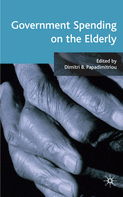
Publications
Government Spending on the Elderly
Edited by Dimitri B. Papadimitriou

The results are in: we are aging—individually and collectively, nationally and globally. In the United States, as in most countries with an advanced economy, the aging of the population will be a primary domestic public policy issue in the coming decades. According to Census Bureau estimates, the proportion of the elderly in the total population will increase, while the proportion of the working-age population is projected to decline. These demographic changes imply a significant growth in the number of beneficiaries in federal entitlement programs. Existing program rules and rapidly escalating health care costs are expected to lead to fiscal pressures, and to pose significant challenges for economic growth.
Coping with an aging population requires action in the near term to forestall more difficult choices in the long term. This book provides an assessment of the forces that drive government spending on retirees and explores alternate means of financing the retirement and health care of older citizens. Probabilistic forecasts and comparative analyses are used to measure the potential impact of various reform proposals. Individual essays examine European welfare state regimes and their generosity toward the elderly, global demographic trends and their implications for social welfare systems, the differing retirement prospects for women and men, the changing role of employer pensions in the United States, the adequacy of retirement resources among the soon-to-retire, and the effects of wage growth on the long-term solvency of Social Security.